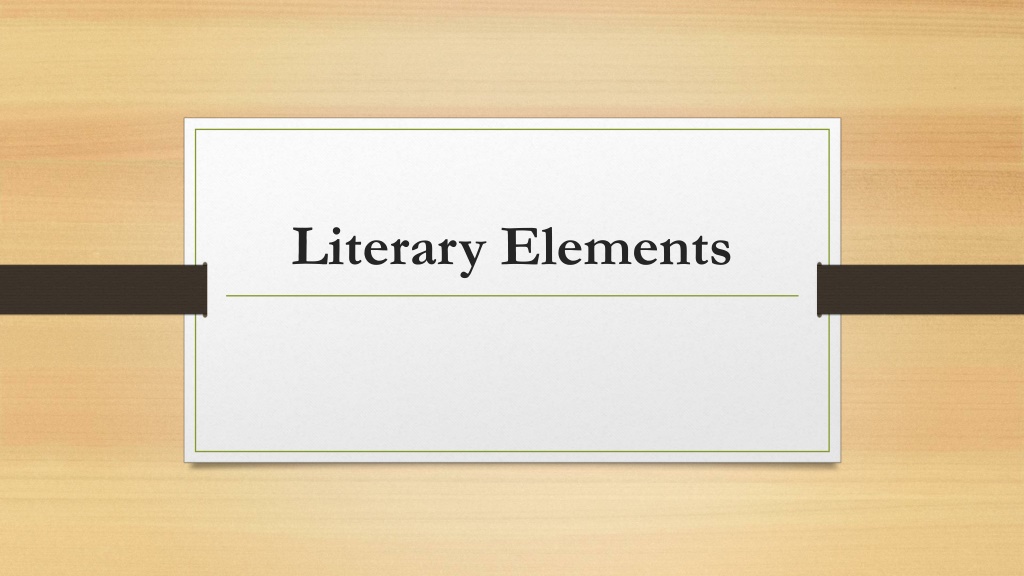Understanding Literary Elements: Characters, Conflict, and Motif
Explore essential literary elements such as types of characters (round, flat, dynamic, static, protagonist, antagonist), characterization (direct and indirect), conflicts (interpersonal, intrapersonal, man vs. nature, man vs. society), and motifs with examples.
Download Presentation

Please find below an Image/Link to download the presentation.
The content on the website is provided AS IS for your information and personal use only. It may not be sold, licensed, or shared on other websites without obtaining consent from the author. Download presentation by click this link. If you encounter any issues during the download, it is possible that the publisher has removed the file from their server.
E N D
Presentation Transcript
Types of Characters Round: A character that has many facets and well developed by the author. Flat: characters who are one-sided and stereotypical.
Types of Characters Dynamic: A character who changes in some fundamental way during the course of the story. Static: A character who remains the same.
Types of Characters Protagonist: the main character in a play, story, or film. Antagonist: the person or force in fiction that opposes the protagonist, or main character.
Characterization Direct: The author develops the personality of characters by direct statements about who they are and what they are like. Indirect: The author reveals a character s personalities through: Character s thoughts Comments from other characters The character s physical appearance
Conflict the struggle between characters or forces in a play, novel, short story, narrative poem, or film.
Types of Conflict Interpersonal - Man vs. Man (person vs. person) One character struggles against another character
Types of Conflict Intrapersonal (Internal) - Person vs. Self A character battles his own weakness, fears, or faults.
Types of Conflict Man vs. Nature: a character is pitted against the forces of nature. Man vs. Society: a struggle between the protagonist and the culture in which he/she lives.
Motif a word, character, object, image, metaphor or idea that recurs in a work or several works
Examples of Motif For example, in Haroun and the Sea of Stories, water is a recurring image prevalent in various parts of the novel. OR In many heroic tales, the hero is a reluctant hero . He/She may be apprehensive to begin a journey.
Mood The attitude of the author toward the subject.
Mood Fantasia frequently uses music and setting to drastically shift the mood from light and playful to dark and foreboding.
Tone The reflection of a writer s attitude, mood, and manner in his or her writing. The attitude of the author toward the audience.
Imagery mental pictures created by the author which would appeal to one or more of our five senses It is important to note that imagery does not just describe what someone sees. It goes deeper than that. It can appeal to ALL of the senses.
Symbolism In a literary work, something which is itself and represents something else, but it has to be present in the work of literature. It is usually an object, but it can be a person or an action. Often drawn from nature. Example - a sunrise might symbolize hope or a new beginning.
Symbolism Example Dumbo s magic feather represents courage and self- confidence. Once he truly believes in himself, he no longer needs it as a psychological crutch.
Theme A statement of observation the author makes about society, human nature, or universal truth, which is the central or dominating idea in the literature. -It is NOT the moral or lesson. -Think-People often ..
Theme Themes are not one-word answers. For example, the theme of Haroun and the Sea of Storiesis NOT storytelling .
Examples of Theme Perseverance usually pays off. First impressions are not always accurate. Love is often found when one is least expecting it. People often overestimate their abilities. People often misjudge others before understanding them.
Allegory a story with an underlying meaning. Characters, events and details have literal and symbolic meanings. For example, the characters and events in Animal Farm (published in 1954) represent people and events of the Russian Revolution of 1917.
Allusion An indirect reference to a work of literature or art or to a well-known person, place, or event. Example: It was like all Hades broke loose -Warriors Don t Cry In The Hunchback of Notre Dame, the gargoyle Laverne tells a flock of pigeons to Fly my pretties! Fly, Fly! la the Wicked Witch of the West in The Wizard of Oz.
If you were trying to instill confidence in a friend and said, Use the force, that would be an allusion to Star Wars. The verb form of allusion is to allude.
Elements of Plot EXPOSITION: INTRODUCES BACKGROUND INFO ABOUT CHARACTERS, SETTING, OR CONFLICT. RISING ACTION: EVENTS THAT DEVELOP THE CONFLICT TO A HIGH POINT OF INTENSITY. CLIMAX: HIGHEST POINT OF INTEREST OR SUSPENSE.
Elements of Plot FALLING ACTION: ANYTHING THAT LEADS TO THE RESOLUTION. RESOLUTION: POINT WHERE CONFLICT IS ENDED/RESOLVED DENOUEMENT: LOOSE ENDS ARE TIED UP. They all lived happily ever after
Elements of Plot A Exposition B Rising Action C Climax D Falling Action E Resolution F Denouement

 undefined
undefined























